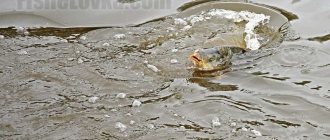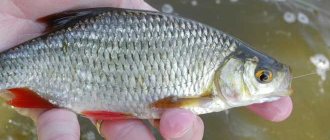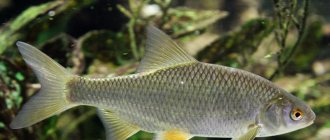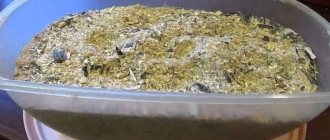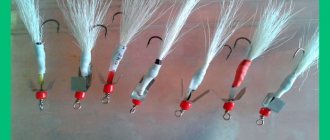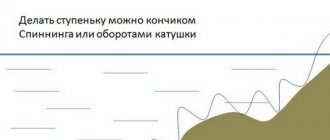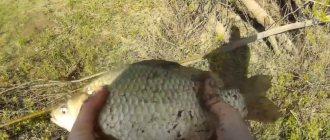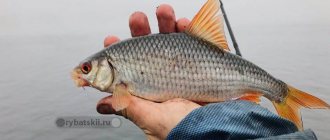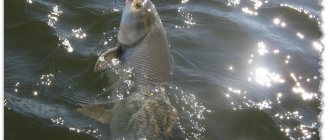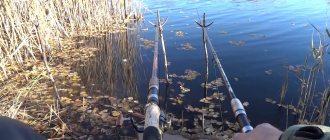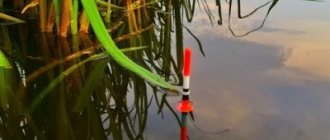Weather has a serious impact on roach behavior. During hot periods, it goes deeper, so it is better not to look for it under the shore. It is difficult to catch during sudden changes in temperature and pressure. As a rule, during such periods she is not interested in any bait.
The float rod is widely popular among fishermen these days, just as it was decades ago, when there was practically no alternative to it. This simple gear is used to catch fish everywhere, and various species, including roach. In this type of fishing, everything is very simple, but you need to stock up on bait, bait, patience and, most importantly, you need to have the fishing rod itself. Despite its simplicity, fishing can be very productive.
In order to successfully fish using this semblance of the “Nottingham” method, you need to know the river perfectly: channel edges, drop-offs into holes, contours of underwater mounds, sharp transitions between bottom soils of various types - this is where schools of feeding fish are concentrated on a large river.
What places does the roach stick to?
Depending on the habitat, not only the behavior of the roach varies greatly, but also its diet . As already noted, the larger “blackback” is adjacent to bream and silver bream and constitutes very serious food competition for them, consuming small mollusks, crustaceans and larvae.
Roach in spring
It’s not easy to find places for such fishing in a spring river: you need a noticeable depth, a weakened current and a fairly clean, but not silted, bottom.
It’s easier, of course, to fish in bays or backwaters, where next to last year’s vegetation there is a depth of at least two meters, and the bottom is sandy, pebble or clay.
Roach in summer
During the entire summer period, large roach on the rivers are from time to time successfully caught from boats along with bream, silver bream and ide. The most widespread method of fishing is “in the race” - long-distance passing of equipment downstream from an anchored boat, from which, together with the load, a mesh feeder filled with steamed bran, cake, and bread remains is lowered to the bottom, giving a long trail of food particles in the current.
In order to successfully fish using this semblance of the “Nottingham” method, you need to know the river perfectly: channel edges, drop-offs into holes, contours of underwater mounds, sharp transitions between bottom soils of various types - this is where schools of feeding fish are concentrated on a large river.
Roach at different times of the fishing season
However, the fisherman himself is free to choose whether to catch all the roach in a row mixed with bleak with bloodworms or small maggots, or, albeit not often, to pull only “marketable” fish out of the water.
The principles of constructing a “roach” rig, depending on the fishing conditions, the technique of using it, as well as methods of activating the bite, will be discussed further.
What is the target interested in? The most effective bait is maggot. The roach willingly takes not only a living, mobile larva, but also a dead one. Some fishermen even specially prepare dead maggots by scalding the living larvae with boiling water. Casters (pupated maggots) are also used, which often catch trophy fish.
Nozzles for catching roach in July
The baits for catching roach at this time of year are various dragonfly larvae, greens, maggots, bread crumbs, and semolina. The semolina chatter is used for catching medium and large roach; when catching small fish in the upper layers of water, the fry quickly eat up this bait, and you have to very often add new portions of the chatter to the hook.
For catching large roach, it is very effective to use steamed pearl barley grains and feed this bait into the lower layers of the water.
There is also an opinion that catching roach in July is more successful with the following baits: bloodworms, maggots, caddis flies, chopped worms. And when the bite subsides, green algae and hemp seeds are used.
Advantages of a float rod
In roach fishing, float tackle has proven itself to be the best. Its advantages are known to everyone, and as for the advantages, they include:
- the ability to fish in all layers of water;
- inconspicuousness and absence of noise at the moment of casting;
- delicately catching hooked fish;
- the ability to use any bait.
Roach stays mostly close to the shore, in or near coastal vegetation, so long-range gear is of little use for such fishing. It moves to depth only in bad weather (for example, in strong winds).
Separately, it is worth mentioning the maneuverability of the float rod. If the need arises to change the place of fishing, you can’t do it quickly with several donks, but float tackle allows you to change points at least every ten minutes.
The plug is another option that comes with blind equipment. Thanks to a decent blank, you can make accurate casts over decent distances and still use the thinnest fishing line. Rod length – from 8 meters.
Catching roach with a fishing rod in summer
In the first month of summer, the coastline is simply dotted with fishermen who certainly want to profit from roach. At this time, the fish swims in areas whose depth is no more than 3-4 meters. Float gear for catching roach in summer is perhaps the most effective and popular among modern fishermen.
[THERE IS AN ANSWER] How to catch live bait from the shore in the summer?
In general, catching roach in the summer with a float rod is an interesting and sometimes even unpredictable activity, which only adds excitement and excitement to such fishing. You won’t need expensive and elite gear here; the simplest and most budget option of gear will do just fine. It is only important to know where to look for fish and what to catch it with. And if suddenly the float turns out to be powerless in some difficult areas, then the feeder tackle will come to the rescue.
How to catch large roach in summer. Habitats used for catching roach tackle, bait and groundbait. Features and subtleties of fishing.
When to catch roach - the best time to catch roach
As mentioned above, roach fishing in July can be carried out almost around the clock. During the day, after sunrise, you should start looking for roach from a shallow depth, 20–25 cm from the surface of the water. As the sun rises, you should try to catch roach in the middle and lower layers of water; only the smallest fish continue to remain at the surface. Catching roach in July brings good results with the fishing method, when all the sinkers are shifted to the float itself; the smallest pellet can be left near the hook for ease of casting the tackle. Roach reacts very well to a slowly lowering bait and, as a rule, never remains indifferent to such a presentation of the bait.
At night and early in the morning, before sunrise, roach fishing in July can be carried out in the upper layers of the water, almost at its very surface, and at this time large specimens of this fish rise to the surface.
Catching large roach and the gear used
Gear used for catching large roach is float rods, feeder rods, bottom rods and side rods if fishing from a boat.
Float rod
A variety of fishing rods can be used for float rods - fly rods, match rods, plug rods, or Bolognese rods. Usually this depends not only on the preferences of the angler himself, but also on the fishing location.
A fly rod is often used to fish from a boat. In this case there is no need for a very long rod. To catch large roach from the shore, it becomes necessary to make long casts and the rod must meet such requirements. It should be long enough. In addition, when fishing from the shore, the coastal zone itself should not be overgrown with trees. Otherwise, it will be simply difficult to maneuver a long rod.
A pole rod is similar to a fly rod, but is usually longer. 10, 15, and even 20 meter blanks are perfect for catching large roach from the shore and allow you to fish at a really decent distance from the coastal zone.
When using a Bolognese rod to catch large roach, it becomes possible to cast a line longer than the rod itself if, for example, you are fishing in the current, or there is wind that will slightly blow the equipment to the side, or away from the casting point. The presence of passage rings and a reel allows such maneuvers to be performed, and if necessary, the equipment is pulled back to its original state.
A match fishing rod consists of several elbows with guide rings, which also allows you to drain the line if necessary, and when using heavy equipment, make long casts. A fishing rod with such equipment is a kind of universal option that can be used for fishing both from a boat and from the shore. The use of a spinning reel significantly expands the capabilities of such a fishing rod.
The line on the fishing rod is set from 0.15 if monofilament fishing line is used, or from 0.08 if braided line is used. It is best to take a float of the “goose feather” type. It should be sensitive enough to show cautious bites from large roach. The hooks are placed in a small size, and this size will also depend on the attachment used. For small bait such as bloodworms, small hooks should be used. Often, to catch roach, a leash made of thinner fishing line or thin fluorocarbon is placed on a fishing rod.
Donka
Feeder
They fish with a feeder in the same way as with a donkey. Moreover, this is the donka, only in a more advanced version. There is no need to think about a nod or other device when fishing with a feeder. On the feeder, the tip acts as a nod and does an excellent job of it. Feeder tips come in different sensitivity and when catching roach, even large ones, you should try to use the most sensitive of them.
When fishing with a feeder, feeders combined with a sinker are usually used. But when fishing for large roach, this is not always necessary. Large roaches do not stay in large flocks, and instead of such a feeder they often use an ordinary sinker of suitable weight. Depending on the equipment, it can be sliding, or in the form of a flat plaque, or a drop. These weights often have a swivel already installed and can be attached directly to the rig's loop without additional carabiners.
[THERE IS AN ANSWER] How to catch a pike on a fishing rod with a float
Onboard fishing rod
If we talk about hooks, then these should be small elements. The best option would be numbers three and four. It must be said that they are thin, so when fishing you need to take spare ones with you just in case, so that if something happens you can make a replacement.
Tackle float
Speaking about color, it should be noted that it should be a “soft” shade that does not hurt the eyes. Therefore, you can choose a green, flesh-colored, blue, white and similar product. This rule is especially important when you have to fish in the shallow area.
You can choose any fishing rod, but you should pay attention to such important details as:
- Using almost invisible and thin fishing line. It is better to pay attention to the fluorocarbon element, which performs best.
- The hook is sharp, but small.
- The float is selected based on the above requirements.
Fishing with a float rod should be calm. The bait should slowly float with the flow of the reservoir and smoothly mix in reservoirs without a current. The roach does not like sudden movements, but she herself does everything carefully and unnoticeably.
Roach bait
Before you go hunting, you need to know: what to use to catch roach? Roaches can peck on plant or live food. It bites well on any worms, rolled oats, only wheat bread, bloodworms, maggots, and corn. It is worth noting that large roaches prefer corn; small roaches simply will not peck at it.
Moreover, her preferences change depending on the time of day. For example, at lunchtime the easiest way to catch fish is on a grasshopper or a bunch of thread-like algae. The roach bait can be in the form of hemp. Other baits are used by experienced fishermen.
In general, it should be noted that catching roach in the summer with a float rod can only use plant baits; the simplest of plant baits is a bunch of algae collected in the same body of water. In addition, this bait covers the hook well; you just need to wrap the seaweed around the hook tip.
Bait is not used for roach, because the fish can actively eat the bait and not pay attention to the baited hook. This is especially important when fishing for roach in the autumn; even during this period it is recommended to use non-nutrient bait. But if the reservoir is deep enough and when hunting large individuals, you can use feeders.
Throw the rigged float at the fishing spot, making sure your bait is near the bottom. To do this, increase the descent of the float until it no longer stands up correctly, then reduce the descent by 20 cm and the float will stand up straight, and your bait will be on the bottom;
Roach fishing in July
The month of July is considered the hottest time of the year, and this is not surprising.
After all, it is in July that the sun rises as high as possible, and the air temperature reaches incredible levels. Naturally, all underwater inhabitants, including roaches, cannot be indifferent to such serious weather changes and this affects their bite. Roach activity remains very good in July. The fish feeds well throughout the sunny day, without giving up this opportunity at night.
The best lures - baits and baits
Maggot is the best bait for roach in spring, summer and autumn. But in the summer, all the fish switch to plant food, so sometimes the bite for maggots will fade, but the bite for sweet corn, flavored dough, bread or boilies will intensify.
In spring and autumn, when fishing for roach, use:
- maggot
- worm
- bloodworm
In summer, especially in hot weather, the following plant attachments will perform better:
- dough
- bread
- pearl barley
- sweet corn
- green pea
- small boilies (read about how to fish with boilies)
Technique for catching roach with a Bolognese fishing rod in a strong current. A practical guide with plenty of tips.
How to catch roach on a feeder - the article will tell you about the correct equipment, bait and bait when feeder fishing for roach in the current and in still water.
Loading a float for effective catching of small fish to make the equipment more sensitive.
4. The plug fishing rod is used in any water systems at distances where the plug can reach: on lakes and ponds, narrow rivers with slow or medium flow, canals.
Groundbait is the roach’s favorite treat. Chebak is responsive to feeding, but remember - it must be constant. Sometimes even a break of 5 minutes is enough for a school of fish to move to a completely different place. The same situation will happen if there is an error in the portion of food - the flock will immediately swim away to the opposite part of the reservoir.
It is necessary to pay special attention to the quantity and composition of the mixture to attract fish. Indicators change in different seasons of the year:
1. Spring. It is best to saturate the composition with bait elements: bloodworms, maggots and chopped worms. The aroma is not sharp, the mixture is light.
[THERE IS AN ANSWER] How to catch pike with live bait in the summer?
2. Summer is the ideal season for using mixtures with steamed millet, pearl barley or corn grains. For dregs, it is allowed to add pea flour. It is best if the bait has a sweet smell.
3. Autumn. This season, use a formulation with ingredients of animal origin. The smell should be animalic or spicy.
- The main point is the correct choice of fishing spot
- After choosing the right place, you need to choose the right gear
- Choose a suitable bait that will help you keep the fish on the spot for a long time
- And last in line, but far from least important, is the choice of bait.
As for complementary food, roach is an unpretentious fish, and both homemade bait and store-bought bait are suitable. Home-made complementary foods are made from flour or bran, as well as various flakes and sunflower cake. The main thing is that the food molds well into small balls that are heavy enough so that they are not carried away by the current and are not broken by water. She should only gradually dilute the complementary foods.
Several interesting bait recipes
There are many interesting, and most importantly time-tested bait recipes for catching roach. I wanted to share just a few of them, the most catchy ones in my opinion.
Recipe No. 1
As an animal component, you can use maggots, bloodworms or crushed worms. You can choose from the following flavors:
- thyme;
- hemp seeds;
- flax seeds;
- cinnamon;
- anise;
- coriander
- caramel;
- honey.
The main thing is not to overdo it with flavorings, as the opposite effect may occur and the fish will, on the contrary, be scared away.
Recipe No. 2
This recipe will require the following ingredients:
- Breadcrumbs (500 grams);
- Finely ground wheat bran (500 grams);
- Corn flour or grits (1000 grams);
- Boiled wheat cereal (600 grams);
- Ground sunflower cake (1000 grams);
- Grated sweet cookies (for example, bird's milk);
- Powdered milk (300 grams);
- Animal component (maggots, crushed worms, bloodworms).
What bait should you use to catch roach?
Lures for catching roach, as for other types of fish, are divided into two types:
- Plant origin. Baits of this type include white and black bread, pickled corn, peas, small boilies, pearl barley, rolled oats, semolina, dough with various flavors and others.
- Animal origin. Lures of this type include bloodworms, worms (dung), crawlers, maggots, grasshoppers and other baits.
An experienced fisherman notices well how the bite changes depending on the time of year: in the summer the fish bite reluctantly, since for the most part they do not feel hungry and at this time baits of plant origin will be most effective. But in the demi-season, in autumn or spring, roach becomes more greedy and bites much more actively. Here other baits of animal origin come to the fore.
For successful fishing, the main thing is to be calm and careful, and also to learn patience so as not to allow the roach to outwit you. It’s worth getting out early in the morning, at dawn, setting up your gear well and not forgetting tasty complementary foods, and then all that’s left to do is enjoy the peculiarly exciting hunt. Good luck to everyone on the ponds and great catches!
The basis of proper roach bait is the dust component. If you buy bait, make sure that the bait is light in color and its fractions are small enough to create clouds of turbidity when it gets into the water.
Baits for summer
Active mechanics is what roaches expect from bait prepared with their own hands in the summer. The “explosive” crumbling mixture will attract fish much faster. If the ball of bait breaks when it hits the surface of the water, and leaves a trail behind it as it dives, you can expect a good catch. Therefore, summer catching sorogi with semolina is not without meaning.
Compound
When selecting components, water temperature is critical. As long as the indicators are within comfortable limits for the fish, they will willingly go for millet and pearl barley. The first croup is more attractive to the large “blackback”, the second – to the “ordinary” roach.
A drop in temperature and an increase in the frequency of precipitation is a signal to abandon large fractions when preparing bait. Instead of high-calorie cereals, they begin to use small food bloodworms, as a result of which the mixture becomes finely dispersed.
Photo 1. Millet is one of the best cereals for groundbait.
Regardless of the environment, you should strive to ensure that the finished product creates turbidity when it enters water. The desired trail will be obtained if the mixture is slightly under-moistened, making it dry. It is also worth including components with different rates of dissolution in water. Some of them must have high buoyancy. The property is inherent:
- coconut flakes;
- oatmeal;
- ground sunflower peel.
Dust is also created by dairy components: infant formula, dry cream. Cocoa also has the required quality.
To get bait that the roach loves and readily eats in the summer, it is necessary to take into account the color perception of the fish.
She is wary of anything that goes beyond her usual range. Unusual and contrasting spots on the water not only do not attract the sorog, but also scare them away. The reaction is more acute at the end of August. Important!
You should not include ingredients in the mixture whose shade is strikingly different from the color of the bottom. Fishing method is another key guideline. When using a float rod on a quiet body of water, the mixture is made light, practically no water or flavorings are added. The bet is made on the nutritional attractiveness of the components included and their slow sinking to the bottom. But if the current is strong, then the bait is made according to the absolutely opposite principle: they strive not for the airiness of the mixture and the rapid disintegration of the ball from it, but for low mobility and slow erosion. The necessary qualities are achieved by introducing into the bait clay, sand and earth collected at the fishing site.
Aromatization
Fish has a well-known sweet tooth. The best scents for roaches include:
- anise;
- caramel;
- maggot attractant;
- vanilla;
- honey;
- coriander.
Most summer recipes include anise, but as the weather gets colder, many fishermen abstain from it. Reason: The supplement stimulates hunger. This quality is required in June and July, but not in the last weeks of summer.
Photo 2. Flavoring the mixture with molasses gives a good effect.
Groundbait recipes
A homemade product often turns out to be more effective, since it is created taking into account all available factors: place, time and method of fishing, climate characteristics and the level of “feeding” of the inhabitants of the reservoir.
Summer Blend
It is used with equal success in June, July and August. For preparation you need:
- millet, semolina (1 glass each);
- barley grits (2 cups);
- water (3 glasses);
- pea flour;
- ground crackers.
The amount of the last ingredient is determined based on the method of fishing. Feeding with balls requires less crumbs, and feeding with feeders requires more. If fishing takes place on the river, then an additional component is added to the preparation: rolled oats flakes.
Photo 3. Breading mixture is often used instead of ground crackers.
The process of making summer bait:
- pour millet with 3 glasses of water, boil;
- add egg and semolina to the resulting porridge;
- Just before feeding, break the mixture with breadcrumbs and sprinkle with pea flour.
The recipe given is basic. Based on it, you can prepare highly targeted mixtures that are ideal for a specific summer month. For the June and July versions you will need large factions:
- small boilies;
- peas;
- pearl barley;
- canned corn;
- pellets
The proportion of large fractions in comparison with the main ingredients should not be high. In August, their percentage is gradually reduced to a minimum, and when a cold front approaches, they are completely abandoned. Reason: cooling of the water reduces the feeding activity of the fish.
Universal mixture
It is distinguished by a pronounced sweet taste and persistent aroma - characteristics that are required when fish mainly consume plant food. To prepare this summer bait for roach with your own hands you will need:
- breadcrumbs (2 kg);
- finely ground bran and corn flour (0.5 kg each);
- baby formula or dry cream (0.3 kg);
- hemp, coconut, sunflower cake (0.1 kg each);
- sweet flavoring (anise, vanilla).
Dry ingredients are mixed, then flavoring is added. The amount of the latter, if necessary, can be increased by 1.5 times - relevant for feeder fishing.
